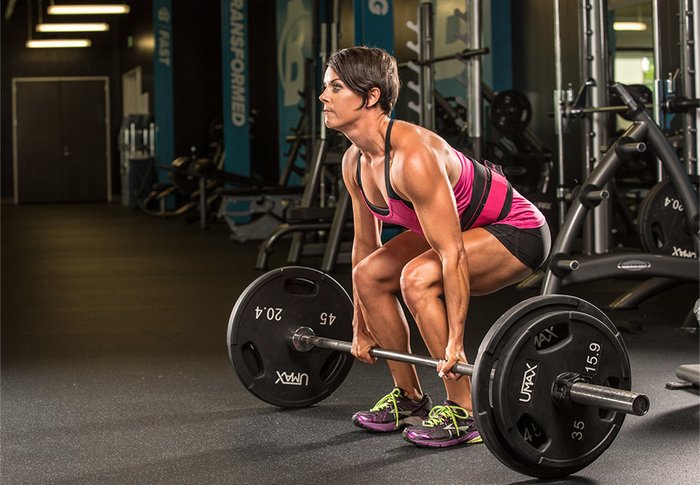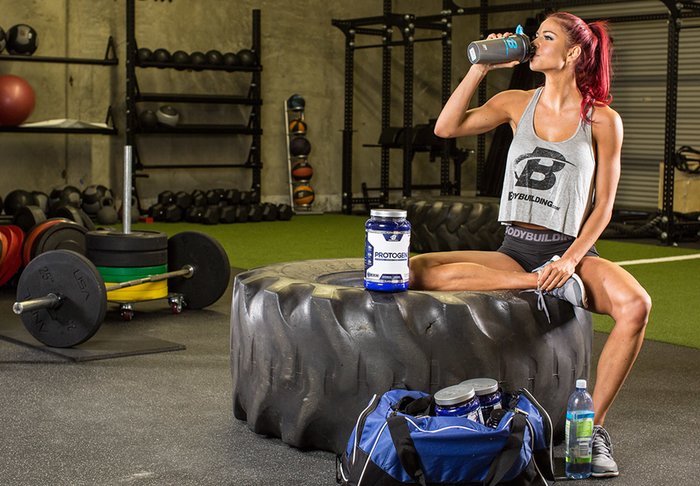Weight loss is no easy feat. But factor in all the misinformation out there, and you've got an even bigger uphill climb. Most of us have tried at least one crazy fad to drop weight—hours on the treadmill, ultrarestrictive diets, cleanses—only to have the weight (plus a few additional pounds) come right back on.
I'm not here to offer any magical advice for effort-free weight loss. All I want to do is clear the road ahead of you a little more to help you win the battle of the bulge! Read these five common weight-loss myths, and never fall prey to them again!
The Myth: Long Cardio Sessions Are Best for Fat Loss
A common misconception amongst many female fitness enthusiasts is that steady-state cardio in the "fat burning zone" is ideal for weight loss. Spending two hours on the treadmill may seem like it'll get you bikini-worthy bod—more minutes, more calories, right? However, while steady-state cardio has many benefits, it isn't the most effective way to reduce body fat.[1]
Some of you probably just breathed a sigh of relief. Seriously, how much bad TV can you be expected to watch in the name of fat-loss?
The Fix: High-Intensity Interval Training (HIIT)
HIIT elicits the same health benefits as steady-state cardio, but can lead to even greater improvements in body composition, glucose metabolism, blood pressure, and cholesterol levels.[1-3] And you definitely burn more calories when you do it! Additionally, the release of hormones like epinephrine increases with high-intensity exercise, which can help your body use more fat for fuel.[1]
HIIT can be implemented in a variety of ways, but it's always built on intervals. You'll perform work at max effort for a number of reps, rounds, or minutes, and then you'll rest. Then, you'll repeat the interval at max effort again.

HIIT elicits the same health benefits as steady-state cardio, but can lead to even greater improvements in body composition, glucose metabolism, blood pressure, and cholesterol levels.
It's important to remember that for calorie expenditure, the greater the muscle mass involved in the exercise, the more calories you will burn. Using cardio machines like a rowing machine or a Jacob's ladder are great, because they engage your entire body. You can also perform circuits with weights or bodyweight moves like push-ups.
Because HIIT is harder on your body than steady-state cardio, you will require adequate rest to gain the most benefits, so don't feel bad for taking a day off. A good rule of thumb is to decrease the number of days you exercise as the load gets heavier. For example, HIIT using just your body weight can be done 3-5 days a week for 20-30 minute sessions.
If you're considering a weighted circuit however, limit yourself to 2-3 days per week for 15-20 minute sessions.
The Myth: Lifting Heavy Isn't Good for Weight Loss
Women's resistance training has a long history of misconceptions and misunderstandings. For decades, women were advised to steer clear of dumbbells weighing more than 10 pounds, or else they would inevitably develop Arnold-like proportions.
Research has consistently debunked this myth. More recently, there has been greater awareness of the benefits of resistance training for women.[4-6] These benefits extend from improving mood to improving posture, with tons of health advantages in between. But it carries over to fat loss as well!
The Fix: Lift Heavy at Least Some of the Time
While many professionals tout light bouts of resistance training for women, the truth is that light weight will only allow the body to adapt to so much. While it may seem counterintuitive, using heavier weights can have a more favorable outcome for weight loss.[7] Not only does heavy resistance training create a greater calorie expenditure for up to 24 hours post-workout, but it can also help you add muscle mass, which helps you burn more calories at rest!

While it may seem counterintuitive, using heavier weights can have a more favorable outcome for weight loss.
About that muscle: While lifting heavier weights in rep ranges of, say, 8-10 reps per set may produce some hypertrophy (muscle growth), the main outcome will be stronger muscles, not necessarily larger ones. The truth is that it's a lot harder than you think to "get muscular."
In other words, you have nothing to fear. And honestly, adding just a little more muscle might be exactly what you need! Aside from burning calories even at rest, it powers better workouts now and in the future.
The Myth: Training Fasted Will Burn More Fat
The rationale goes like this: If you haven't eaten, your body will have low levels of glucose and insulin, which means your body will have to utilize its fat stores for energy.
Although it seems good in theory, the major issue with training in a fasted state is that the weight loss could be coming from a loss of muscle mass, which is exactly what you don't want. Training without proper nutrition makes it very difficult for your body to replenish and recover from the protein breakdown that occurs during a bout of exercise. Therefore, the body ends up sacrificing muscle mass because there are no available amino acids for muscle protein synthesis.
One more thing that a lot of people have to learn the hard way: Training when you're starving leads to low-quality workouts!
The Fix: A Pre-Workout Protein Shake
Rather than training hungry, drink a protein shake before you go. One scoop, or about 20 grams, is sufficient. Whey is a great choice because it's easy on the stomach, quickly absorbed, and has an enormous list of additional benefits. Numerous studies have shown that ingesting more high-quality protein leads to both increases in muscle mass and decreases in fat mass.[8]

Numerous studies have shown that ingesting more high-quality protein leads to both increases in muscle mass and decreases in fat mass.
Ingesting protein before a workout can also limit insulin spikes, assuring that fat utilization still occurs during the workout. Plus, depending on the timing of ingestion, the additional amino acids can either decrease the level of protein breakdown or promote muscle protein synthesis.[9] Both are necessary to build and preserve muscle.
If eating too close to a workout doesn't work for your stomach, try a casein shake two hours before your workout. This slow-digesting protein will provide your body with a constant stream of amino acids without the potential discomfort.
The Myth: An Extreme Calorie Deficits Is Necessary for Weight Loss
When we want to see results, patience goes out the window. Tell me if you've had this train of thought: "If reducing my caloric intake by 500 calories can help me lose 1 pound per week, imagine what lowering my calories by 1000 can do!"
In reality, extreme caloric deficits may seem like a great idea for rapid weight loss, but they should only be used by people with extreme health concerns, and only under the care of a knowledgeable medical professional team.[10]
Listen up ladies! Drastically reducing your calories can lead to metabolic complications that actually make it harder for you to burn fat—and easier to add it. They can also lead to loss of muscle mass, decreases in bone mineral density, negative effects on brain function, and headaches.[11]

Listen up ladies! Drastically reducing your calories can lead to metabolic complications that actually make it harder for you to burn fat—and easier to add it.
Additionally, these diets may lead to nutrient deficiencies. Reductions in micronutrients like iron, vitamin D, and calcium won't just effect your performance and energy levels in the gym, but can make weight loss and weight management more difficult.
The Fix: Make Minor Adjustments and Stick to Them
Experts typically recommend reducing your daily intake by about 300-500 calories per day below "maintenance level," or the amount you need to stay at your current weight. This decrease in calories converts to about 1/2 pound to a pound of weight loss per week. Although you may feel like you can "do more," slow, steady progress is much healthier—and easier to keep up.
The best way to track what you eat so you know you're hitting your calories with healthy food is with a food diary. There are numerous free apps you can download such as MyFitnessPal or Lose It! to help track. Before you start using them, modify the settings to the appropriate calorie and macronutrient level your body needs.
The Myth: Cleanses Rid the Body of Toxins
We've all heard about the miracle detoxes and cleanses that can help you lose weight and flush out toxins. However, these programs just mimic the natural detoxing systems your body already has in place.
Keep in mind that your body is already equipped with all the necessary tools to help detoxify itself. Organs like the liver, the kidneys, and the colon are all involved with processing nutrients and removing excess waste.
Any weight loss that occurs because of these programs is almost always connected to a dramatic reduction in calories, not magical properties of the program itself. However, sudden and dramatic dietary changes can cause losses in muscle mass and general fatigue, as well as more serious complications such as disrupted gut bacteria, deficiencies in vital micronutrients, and even organ damage.[12]
Sure, you may lose some weight on a cleanse, but once you resume your normal calorie intake, you can bet your bottom dollar those pounds will come right back.
The Fix: Long-Term Health Awareness
Ditch the short-term mentality. Healthy lifestyle habits like better sleep quality and quantity, hydration, and reducing refined sugars can lead to major improvements. These changes might be subtle, but they'll aid in weight loss and help build an overall healthier body.

Healthy lifestyle habits like better sleep quality and quantity, hydration, and reducing refined sugars can lead to major improvements.
There's no need to make things more complicated with magic potions! Eat whole, healthy food, and exercise regularly. Your body will take care of the rest.
References
- Boutcher, S. H. (2010). High-intensity intermittent exercise and fat loss. Journal of Obesity, 2011.
- Wisløff, U., Ellingsen, Ø., & Kemi, O. J. (2009). High-intensity interval training to maximize cardiac benefits of exercise training? Exercise and Sport Sciences Reviews, 37(3), 139-146.
- Swain, D. P., & Franklin, B. A. (2006). Comparison of cardioprotective benefits of vigorous versus moderate intensity aerobic exercise. The American Journal of Cardiology, 97(1), 141-147.
- Kraemer, W. J., Nindl, B. C., Ratamess, N. A., Gotshalk, L. A., Volek, J. S., Fleck, S. J., ... & Hakkinen, K. E. I. J. O. (2004). Changes in muscle hypertrophy in women with periodized resistance training. Medicine and Science in Sports and Exercise, 36(4), 697-708.
- Szivak, T. K., Hooper, D. R., Dunn-Lewis, C., Comstock, B. A., Kupchak, B. R., Apicella, J. M., ... & Kraemer, W. J. (2013). Adrenal cortical responses to high-intensity, short rest, resistance exercise in men and women. The Journal of Strength & Conditioning Research, 27(3), 748-760.
- Kelley, G. A., Kelley, K. S., & Tran, Z. V. (2001). Resistance training and bone mineral density in women: a meta-analysis of controlled trials. American Journal of Physical Medicine & Rehabilitation, 80(1), 65-77.
- Josse, A. R., Tang, J. E., Tarnopolsky, M. A., & Phillips, S. M. (2010). Body composition and strength changes in women with milk and resistance exercise. Medicine and Science in Sports and Exercise, 42(6), 1122-1130.
- Josse, A. R., Atkinson, S. A., Tarnopolsky, M. A., & Phillips, S. M. (2011). Increased consumption of dairy foods and protein during diet-and exercise-induced weight loss promotes fat mass loss and lean mass gain in overweight and obese premenopausal women. The Journal of nutrition, 141(9), 1626-1634.
- Frestedt, J. L., Zenk, J. L., Kuskowski, M. A., Ward, L. S., & Bastian, E. D. (2008). A whey-protein supplement increases fat loss and spares lean muscle in obese subjects: a randomized human clinical study. Nutrition and Metabolism (Lond), 5(1), 8.
- Sellahewa, L., Khan, C., Lakkunarajah, S., & Idris, I. (2015). A systematic review of evidence on the use of very low calorie diets in people with diabetes. Current Diabetes Reviews [epub ahead of print].
- Müller, M. J., Enderle, J., Pourhassan, M., Braun, W., Eggeling, B., Lagerpusch, M., ... & Bosy-Westphal, A. (2015). Metabolic adaptation to caloric restriction and subsequent refeeding: the Minnesota Starvation Experiment revisited. The American Journal of Clinical Nutrition, 102(4), 807-819.
- Lien, Y. H. H. (2013). Juicing is not all juicy. The American Journal of Medicine, 126(9), 755-756.

